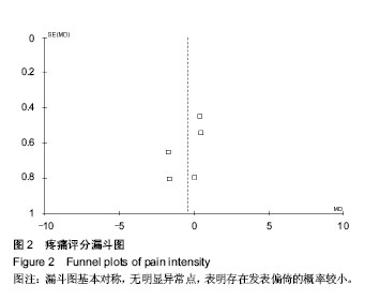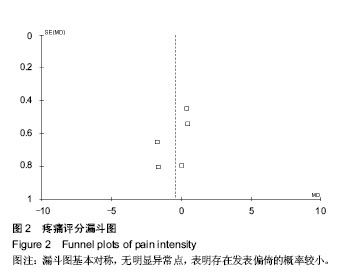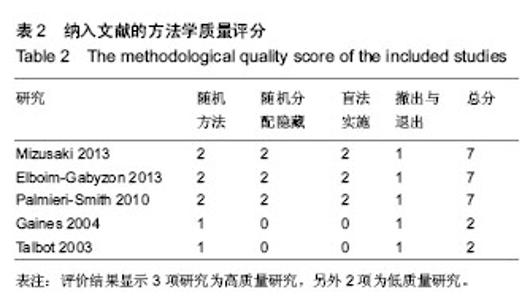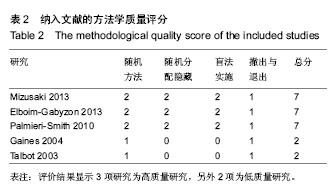Chinese Journal of Tissue Engineering Research ›› 2014, Vol. 18 ›› Issue (38): 6228-6232.doi: 10.3969/j.issn.2095-4344.2014.38.028
Efficacy of neuromuscular electrical stimulation on pain of patients with knee osteoarthritis: a meta-analysis
Xie Dong-xing, Wang Yi-lun, Li Hui, Yang Tuo, Deng Zhen-han, Yang Ye, Zhang Yi, Ding Xiang, Lei Guang-hua
- Department of Orthopedics, Xiangya Hospital of Central South University, Changsha 410008, Hunan Province, China
-
Received:2014-08-19Online:2014-09-10Published:2014-09-10 -
Contact:Lei Guang-hua, M.D., Professor, Chief physician, Doctoral supervisor, Department of Orthopedics, Xiangya Hospital of Central South University, Changsha 410008, Hunan Province, China -
About author:Xie Dong-xing, Studying for master’s degree, Department of Orthopedics, Xiangya Hospital of Central South University, Changsha 410008, Hunan Province, China -
Supported by:the National Natural Science Foundation of China, No. 81272034; the Scientific Research Project of the Development and Reform Commission of Hunan Province, No. [2013]1199; the Scientific Research Project of Science and Technology Office of Hunan Province, No. 2013SK2018; the Doctoral Scientific Fund Project of the Ministry of Education of China, No. 20120162110036
CLC Number:
Cite this article
Xie Dong-xing, Wang Yi-lun, Li Hui, Yang Tuo, Deng Zhen-han, Yang Ye, Zhang Yi, Ding Xiang,Lei Guang-hua. Efficacy of neuromuscular electrical stimulation on pain of patients with knee osteoarthritis: a meta-analysis[J]. Chinese Journal of Tissue Engineering Research, 2014, 18(38): 6228-6232.
share this article
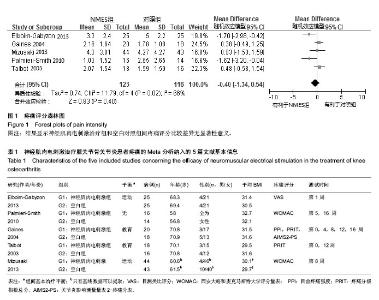
2.1 纳入研究的基本流程 根据检索词被鉴定出的文献568篇,评估合格性的文献8篇,排除同一个研究团队重复报道1篇,缺乏基线数据1篇,未设置对照组1篇,最终纳入5篇文献[17-21],均为英文文献,5项研究均为随机对照试验。 2.2 纳入研究的基本资料和方法学质量评价 5篇文献均为英文文献,其中3篇来自美国,1篇来自巴西,另外1篇来自以色列。采用改良Jadad量表对5项研究的方法学质量进行评价,总分1-3分为低质量研究,5-7分为高质量研究,评价结果显示3项研究为高质量研究,另外2项为低质量研究。纳入研究的基本资料见表1,纳入文献的方法学质量评分见表2。 2.3 Meta分析结果 纳入的5项研究均将患者疼痛的主观评分作为主要结局指标,并且均报告了均数和标准差。5项研究共包括受试对象239例,其中实验组123例,对照组"
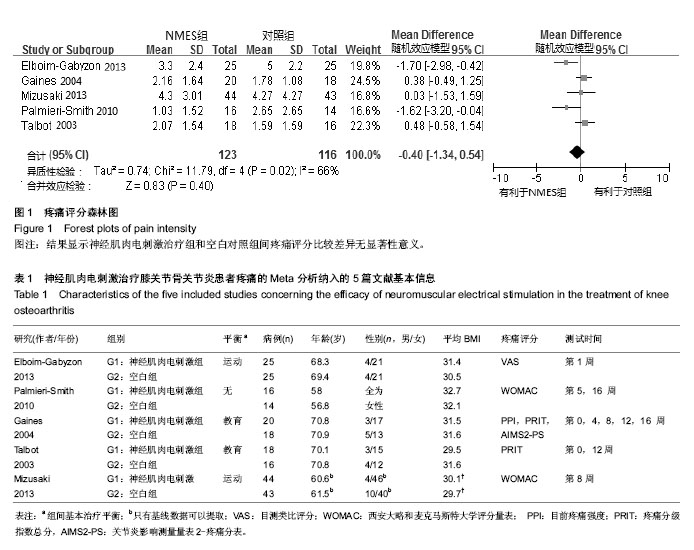
| [1] Felson DT, Zhang Y, Hannan MT, et al. The incidence and natural history of knee osteoarthritis in the elderly. Arthritis Rheum.1995;38:1500-1505. [2] Reginster JY. The prevalence and burden of arthritis. Rheumatology.2002; 41 (Suppl 1): 3-6. [3] Lawrence RC, Felson DT, Helmick CG, et al. Estimates of the prevalence of arthritis and other rheumatic conditions in the United States.Arthritis Rheum. 2008; 58(1): 26-35. [4] Felson DT, Zhang Y. An update on the epidemiology of knee and hip osteoarthritis with a view to prevention. Arthritis Rheum.1989;41:1343-1355. [5] Jones A, Doherty M. ABC of Rheumatology:osteoarthritis. BMJ.1995; 310: 457-60. [6] Ling SM, Bathon JM. Osteoarthritis in older adults. J Am Geriatr Soc.1998; 46:216-225. [7] Hochberg MC, Altman RD, April KT, et al. American College of Rheumatology 2012 recommendations for the use of nonpharmacologic and pharmacologic therapies in osteoarthritis of the hand, hip, and knee. Arthritis Rheum. 2012; 64(4): 465-474. [8] 孙嘉利,范建中.骨关节炎的物理疗法研究进展[J].实用医药杂志,2004,21(8):752-755. [9] 燕铁斌.神经肌肉电刺激及其临床应用[J].继续医学教育, 2006, 20(30): 30-33. [10] Osiri M, Welch V, Brosseau L, et al.Transcutaneous electrical nerve stimulation for knee osteoarthritis. Cochrane Database Syst Rev.2000; (4): CD002823. [11] Marian AM, Marilyn KS. The role of physical therapy and modalities in pain management. Rheumatic Disease Clinic of North American.1999; 25(1): 233-248. [12] Tok F, Aydemir K, Peker F, et al. The effects of electrical stimulation combined with continuous passive motion versus isometric exercise on symptoms, functional capacity, quality of life and balance in knee osteoarthritis: randomized clinical trial. Rheumatol Int.2009: 1-5. [13] Durmus D, Alayli G and Canturk F. Effects of quadriceps electrical stimulation program on clinical parameters in the patients with knee osteoarthritis. Clin Rheumatol.2007;26: 674-678. [14] Rosemffet MG,Schneeberger EE,Citera G,et al.Effects of functional electrostimulation on pain, muscular strength, and functional capacity in patients with osteoarthritis of the knee. J Clin Rheumatol.2004; 10: 246-249. [15] Kocaman Ö, Koyuncu H, Dinç A, et al. The Comparison of the effects of electrical stimulation and exercise in the treatment of knee osteoarthritis. Turkish J Phys Med Rehabil, 2008; 54: 54-58. [16] Burch FX, Tarro JN, Greenberg JJ, et al. Evaluating the benefits of patterned stimulation in the treatment of osteoarthritis of the knee. A multi-center, randomized, single-blind, controlled study with an independent masked evaluator. Osteoarthritis Cartilage.2008; 16: 865-872. [17] Talbot LA, Gaines JM, Ling SM, et al. A homebased protocol of electrical muscle stimulation for quadriceps muscle strength in older adults with osteoarthritis of the knee. J Rheumatol.2003; 30: 1571-1578. [18] Gaines JM, Metter EJ and Talbot LA. The effect of neuromuscular electrical stimulation on arthritis knee pain in older adults with osteoarthritis of the knee. Appl Nurs Res. 2004; 17: 201-206. [19] Palmieri-Smith RM, Thomas AC, Karvonen-Gutierrez C, et al. A clinical trial of neuromuscular electrical stimulation in improving quadriceps muscle strength and activation among women with mild and moderate osteoarthritis. Phys Ther. 2010; 90: 144-1452. [20] Elboim-Gabyzon M, Rozen N,Laufer Y.Does neuromuscular electrical stimulation enhance the effectiveness of an exercise programme in subjects with knee osteoarthritis? A randomized controlled trial. Clin Rehabil.2013; 27(3): 246-257. [21] Mizusaki Imoto A, Peccin S, Gomes da Silva KN, et al. Effects of Neuromuscular Electrical Stimulation Combined with Exercises versus an Exercise Program on the Pain and the Function in Patients with Knee Osteoarthritis: A Randomized Controlled Trial. Biomed Res Int.2013; 2013: 272018. [22] Shapiro S, Cameron M. Physical Agents in Rehabilitation: From Research to Practice. 249-254.Saunders Elsevier Science, St. Louis, Mo, USA.2003. [23] Farrar JT, Young JP Jr, LaMoreaux L. Clinical importance of changes in chronic pain intensity measured on an 11-point numerical pain rating scale. Pain.2001;94(2):149-158. [24] Ettinger WH Jr, Burns R, Messier SP, et al. A randomized trial comparing aerobic exercise and resistance exercise with a health education program in older adults with knee osteoarthritis. The Fitness Arthritis and Seniors Trial (FAST). JAMA. 1997; 277(1): 25-31. [25] Lorig K, González VM, Laurent DD, et al. Arthritis self-management program variations: three studies. Arthritis Care Res.1998; 11(6): 448-454. [26] Flores RH, Hochberg MC. Medical management of osteoarthritis.Contemporary Internal Medicine.1995; 7(6): 32-36,41-42. [27] Giggins O, Fullen B, Coughlan G. Neuromuscular electrical stimulation in the treatment of knee osteoarthritis: a systematic review and meta-analysis. Clin Rehabil.2012; 26(10): 867-881. [28] Gaines JM. The effects of neuromuscular electrical stimulation on chronic knee pain and functional performance in older adults with osteoarthritis of the knee. PhD thesis, Johns Hopkins University.2002. [29] Lake DA. Neuromuscular Electrical Stimulation: An Overview and its Application in the Treatment of Sports Injuries.Sports Medicine 1992; 13(5): 320-336. [30] Bergquist AJ, Clair JM, Lagerquist O. Neuromuscular electrical stimulation: implications of the electrically evoked sensory volley. Eur J Appl Physiol, 2011; 111: 2409-2426. [31] de Oliveira Melo M, Aragão FA, Vaz MA. Neuromuscular electrical stimulation for muscle strengthening in elderly with knee osteoarthritis - a systematic review. Complement Ther Clin Pract. 2013; 19(1): 27-31. [32] Malone JK, Blake C, Caulfield B. Neuromuscular electrical stimulation (NMES) during recovery from exercise: A systematic review. J Strength Cond Res. 2014; 18. [Epub ahead of print]. [33] Maffiuletti NA,Minetto MA,Farina D,et al.Electrical stimulation for neuromuscular testing and training: state-of-the art and unresolved issues. Eur J Appl Physiol. 2011; 111(10): 2391-2397. |
| [1] | Li Dadi, Zhu Liang, Zheng Li, Zhao Fengchao. Correlation of total knee arthroplasty efficacy with satisfaction and personality characteristics [J]. Chinese Journal of Tissue Engineering Research, 2021, 25(9): 1346-1350. |
| [2] | Wei Wei, Li Jian, Huang Linhai, Lan Mindong, Lu Xianwei, Huang Shaodong. Factors affecting fall fear in the first movement of elderly patients after total knee or hip arthroplasty [J]. Chinese Journal of Tissue Engineering Research, 2021, 25(9): 1351-1355. |
| [3] | Peng Zhihao, Feng Zongquan, Zou Yonggen, Niu Guoqing, Wu Feng. Relationship of lower limb force line and the progression of lateral compartment arthritis after unicompartmental knee arthroplasty with mobile bearing [J]. Chinese Journal of Tissue Engineering Research, 2021, 25(9): 1368-1374. |
| [4] | Lü Zhen, Bai Jinzhu. A prospective study on the application of staged lumbar motion chain rehabilitation based on McKenzie’s technique after lumbar percutaneous transforaminal endoscopic discectomy [J]. Chinese Journal of Tissue Engineering Research, 2021, 25(9): 1398-1403. |
| [5] | Huang Dengcheng, Wang Zhike, Cao Xuewei. Comparison of the short-term efficacy of extracorporeal shock wave therapy for middle-aged and elderly knee osteoarthritis: a meta-analysis [J]. Chinese Journal of Tissue Engineering Research, 2021, 25(9): 1471-1476. |
| [6] | Gao Yan, Zhao Licong, Zhao Hongzeng, Zhu Yuanyuan, Li Jie, Sang Deen. Alteration of low frequency fluctuation amplitude at brain-resting state in patients with chronic discogenic low back pain [J]. Chinese Journal of Tissue Engineering Research, 2021, 25(8): 1160-1165. |
| [7] | Liu Xiangxiang, Huang Yunmei, Chen Wenlie, Lin Ruhui, Lu Xiaodong, Li Zuanfang, Xu Yaye, Huang Meiya, Li Xihai. Ultrastructural changes of the white zone cells of the meniscus in a rat model of early osteoarthritis [J]. Chinese Journal of Tissue Engineering Research, 2021, 25(8): 1237-1242. |
| [8] | Zhong Hehe, Sun Pengpeng, Sang Peng, Wu Shuhong, Liu Yi. Evaluation of knee stability after simulated reconstruction of the core ligament of the posterolateral complex [J]. Chinese Journal of Tissue Engineering Research, 2021, 25(6): 821-825. |
| [9] | Zhao Zhongyi, Li Yongzhen, Chen Feng, Ji Aiyu. Comparison of total knee arthroplasty and unicompartmental knee arthroplasty in treatment of traumatic osteoarthritis [J]. Chinese Journal of Tissue Engineering Research, 2021, 25(6): 854-859. |
| [10] | Liu Shaohua, Zhou Guanming, Chen Xicong, Xiao Keming, Cai Jian, Liu Xiaofang. Influence of anterior cruciate ligament defect on the mid-term outcome of fixed-bearing unicompartmental knee arthroplasty [J]. Chinese Journal of Tissue Engineering Research, 2021, 25(6): 860-865. |
| [11] | Zhang Nianjun, Chen Ru. Analgesic effect of cocktail therapy combined with femoral nerve block on total knee arthroplasty [J]. Chinese Journal of Tissue Engineering Research, 2021, 25(6): 866-872. |
| [12] | Wu Gang, Chen Jianwen, Wang Shilong, Duan Xiaoran, Liu Haijun, Dong Jianfeng. Simple HyProCure subtalar stabilization in treatment of adolescent flexible flatfoot combined with painful accessory navicular bone [J]. Chinese Journal of Tissue Engineering Research, 2021, 25(6): 901-905. |
| [13] | Huang Dengcheng, Wang Zhike, Cao Xuewei. Intravenous, topical tranexamic acid alone or their combination in total knee arthroplasty: a meta-analysis of randomized controlled trials [J]. Chinese Journal of Tissue Engineering Research, 2021, 25(6): 948-956. |
| [14] | Li Yan, Wang Pei, Deng Donghuan, Yan Wei, Li Lei, Jiang Hongjiang. Electroacupuncture for pain control after total knee arthroplasty: a meta-analysis [J]. Chinese Journal of Tissue Engineering Research, 2021, 25(6): 957-963. |
| [15] | He Xiangzhong, Chen Haiyun, Liu Jun, Lü Yang, Pan Jianke, Yang Wenbin, He Jingwen, Huang Junhan. Platelet-rich plasma combined with microfracture versus microfracture in the treatment of knee cartilage lesions: a meta-analysis [J]. Chinese Journal of Tissue Engineering Research, 2021, 25(6): 964-969. |
| Viewed | ||||||
|
Full text |
|
|||||
|
Abstract |
|
|||||
